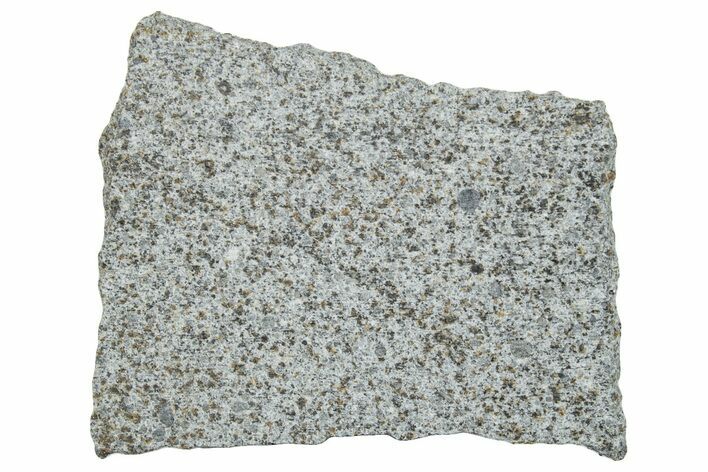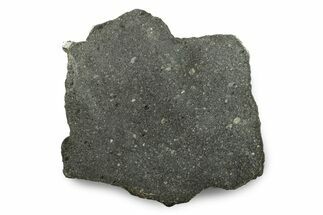This Specimen has been sold.
2" El Hammami Chondrite Meteorite Slice (29.8 g) - Mauritania
This is a 2" wide (29.8 gram) slice of the El Hammami meteorite from Tiris Zemmour in Mauritania.
The El Hammami Meteorite
This meteorite was originally sold to collectors in January of 1997 near the town of Mhamid, Morocco. The nomads who found the material claimed that they collected it from an observed fall in 1995, believed to be in Algeria. The nomads produced more material in September 1997, claiming it was from an observed fall the month prior. Similar meteorite material was subsequently collected from the base of the El Hammami Mountains in Mauritania, about 1,000 kilometers south of Mhamid. Western meteorite dealers recognized that all the samples came from the same meteorite and renamed it El Hammami for the correct location. While the information provided by the nomads was inconsistent, the freshness of the material still hints at a strong possibility that the meteorite was in fact an observed fall.
El Hammami is an H5 (high-iron, metamorphosed) chondrite and is relatively fresh, displaying lots of metal and dark chondrules in a light matrix.
Meteoritical Bulletin: Entry for The El Hammami Meteorite
This meteorite was originally sold to collectors in January of 1997 near the town of Mhamid, Morocco. The nomads who found the material claimed that they collected it from an observed fall in 1995, believed to be in Algeria. The nomads produced more material in September 1997, claiming it was from an observed fall the month prior. Similar meteorite material was subsequently collected from the base of the El Hammami Mountains in Mauritania, about 1,000 kilometers south of Mhamid. Western meteorite dealers recognized that all the samples came from the same meteorite and renamed it El Hammami for the correct location. While the information provided by the nomads was inconsistent, the freshness of the material still hints at a strong possibility that the meteorite was in fact an observed fall.
El Hammami is an H5 (high-iron, metamorphosed) chondrite and is relatively fresh, displaying lots of metal and dark chondrules in a light matrix.
Meteoritical Bulletin: Entry for The El Hammami Meteorite
About Chondrites
Chondrites are stony (non-metallic) meteorites that have not been modified by either melting or differentiation of the parent body. They are formed when various types of dust and small grains in the early Solar System accreted to form primitive asteroids. Some such bodies are captured in the planet’s gravity well and pulled to the surface. They are by far the most common type of meteorite, representing about 86 percent of all meteorites that have fallen to Earth.
Prominent among the components present in chondrites are the enigmatic chondrules, millimeter-sized spherical objects that originated as freely floating, molten or partially molten droplets in space; most chondrules are rich in the silicate minerals olivine and pyroxene. Chondrites also contain particles of various metals such as nickel, iron, and aluminum. These formed at the very beginning of the solar system and aggregated over time: they are the oldest rocks known on Earth!
Chondrites are divided into about fifteen distinct groups on the basis of their mineralogy, bulk chemical composition, and oxygen isotope compositions. The various chondrite groups likely originated on separate asteroids or groups of related asteroids. Each chondrite group has a distinctive mixture of chondrules, refractory inclusions, matrix (dust), characteristic chondrule sizes, and other components. Other ways of classifying chondrites include weathering and shock. The L chondrite group is the most common of these.
Chondrites are stony (non-metallic) meteorites that have not been modified by either melting or differentiation of the parent body. They are formed when various types of dust and small grains in the early Solar System accreted to form primitive asteroids. Some such bodies are captured in the planet’s gravity well and pulled to the surface. They are by far the most common type of meteorite, representing about 86 percent of all meteorites that have fallen to Earth.
Prominent among the components present in chondrites are the enigmatic chondrules, millimeter-sized spherical objects that originated as freely floating, molten or partially molten droplets in space; most chondrules are rich in the silicate minerals olivine and pyroxene. Chondrites also contain particles of various metals such as nickel, iron, and aluminum. These formed at the very beginning of the solar system and aggregated over time: they are the oldest rocks known on Earth!
Chondrites are divided into about fifteen distinct groups on the basis of their mineralogy, bulk chemical composition, and oxygen isotope compositions. The various chondrite groups likely originated on separate asteroids or groups of related asteroids. Each chondrite group has a distinctive mixture of chondrules, refractory inclusions, matrix (dust), characteristic chondrule sizes, and other components. Other ways of classifying chondrites include weathering and shock. The L chondrite group is the most common of these.
TYPE
Chondrite (H5)
LOCATION
Tiris Zemmour, Mauritania
SIZE
2 x 1.7", .2" thick , 29.8 grams
CATEGORY
ITEM
#263183
 Reviews
Reviews












